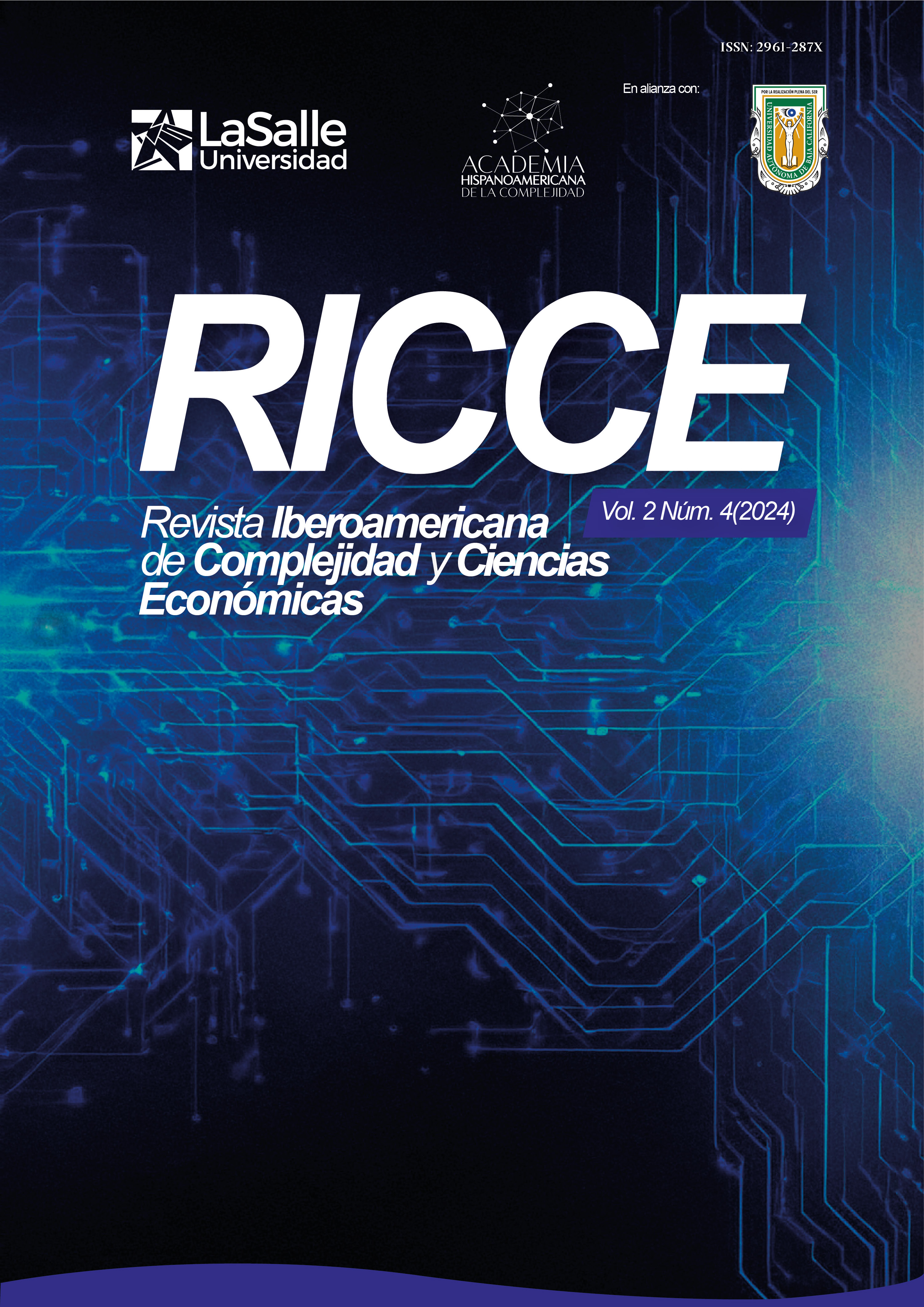Sinergia de IA y Factores Humanos: Innovación y Complejidad en el Desarrollo de Nuevos Productos en la Industria 4.0
Resumen
En este documento se explora cómo la Industria 4.0, basada en tecnologías avanzadas como la inteligencia artificial (IA), los sistemas ciberfísicos y el big data, transforma el desarrollo de nuevos productos (NPD) mediante la integración de factores humanos y tecnológicos. Se analiza el enfoque de complejidad como marco teórico para comprender las interacciones no lineales, adaptativas y emergentes en sistemas productivos complejos. La investigación identifica los desafíos y oportunidades en la creación de valor sostenible, destacando la importancia de la colaboración humano-tecnológica. Se analizan herramientas tecnológicas y se proponen modelos híbridos de decisión para abordar la incertidumbre y mejorar la innovación. Asimismo, se resalta cómo la IA puede amplificar la creatividad humana al ofrecer capacidades predictivas que complementan el juicio humano. El documento concluye que la integración sinérgica de la IA y los factores humanos es esencial para enfrentar la complejidad de los sistemas modernos y promover un desarrollo sostenible e innovador. Las recomendaciones incluyen fomentar modelos adaptativos, diseñar herramientas híbridas y fortalecer la capacitación multidisciplinaria en entornos de complejidad.
Descargas
Citas
Ahumada-Tello, E., Evans, R. (2023). Human factors, innovation and technology, and cluster strategies as triggers of new product development. Procedia CIRP. 119, 179-181. https://doi.org/10.1016/j.procir.2023.03.090 DOI: https://doi.org/10.1016/j.procir.2023.03.090
Ahumada-Tello, E., Evans, R. (2023b). A Complexity-based Framework for Social Product Development. Procedia CIRP. 119. 1204-1209. https://doi.org/10.1016/j.procir.2023.05.009 DOI: https://doi.org/10.1016/j.procir.2023.05.009
Akgün, A. E., Keskin, H., & Byrne, J. C. (2014). Complex adaptive systems theory and firm product innovativeness. Journal of Engineering and Technology Management. DOI: 10.1016/J.JENGTECMAN.2013.09.003 DOI: https://doi.org/10.1016/j.jengtecman.2013.09.003
Anantrasirichai, N., & Bull, D. (2020). Artificial intelligence in the creative industries: a review. Artificial Intelligence Review, 55, 589-656. https://doi.org/10.1007/s10462-021-10039-7 DOI: https://doi.org/10.1007/s10462-021-10039-7
Barile, S., Bassano, C., Piciocchi, P., Vito, P., & Spohrer, J. C. (2022). Algorithms and Human Creativity: Threats or Opportunities? The Human Side of Service Engineering. https://doi.org/10.54941/ahfe1002563 DOI: https://doi.org/10.54941/ahfe1002563
Benabdellah, A. C., Bouhaddou, I., & Benghabrit, A. (2019). Holonic multi-agent system for modeling complexity structures of Product Development Process. 2019 4th World Conference on Complex Systems (WCCS). DOI: 10.1109/ICoCS.2019.8930714 DOI: https://doi.org/10.1109/ICoCS.2019.8930714
Canan, M., Sousa-Poza, A., & Dean, A. (2017). Complex Adaptive Behavior of Hybrid Teams. Procedia Computer Science, 114, 139-148. https://doi.org/10.1016/J.PROCS.2017.09.013 DOI: https://doi.org/10.1016/j.procs.2017.09.013
Casadiego, J., Nitzan, M., Hallerberg, S., & Timme, M. (2017). Model-free inference of direct network interactions from nonlinear collective dynamics. Nature Communications, 8. https://doi.org/10.1038/s41467-017-02288-4 DOI: https://doi.org/10.1038/s41467-017-02288-4
Choi, T. M., Wallace, S. W., & Wang, Y. (2018). Big Data Analytics in Operations Management. Production and Operations Management, 27(10), 1868-1883. https://doi.org/10.1111/poms.12838 DOI: https://doi.org/10.1111/poms.12838
Gallala, A., Kumar, A. A., Hichri, B., & Plapper, P. (2022). Digital Twin for Human–Robot Interactions by Means of Industry 4.0 Enabling Technologies. Sensors (Basel, Switzerland), 22. https://doi.org/10.3390/s22134950 DOI: https://doi.org/10.3390/s22134950
Guo, M., Zhang, Q., Liao, X., Chen, F. Y., & Zeng, D. (2019). A hybrid machine learning framework for analyzing human decision-making through learning preferences. Omega. https://doi.org/10.1016/j.omega.2020.102263 DOI: https://doi.org/10.1016/j.omega.2020.102263
Hermann, M., Pentek, T., & Otto, B. (2016). Design Principles for Industrie 4.0 Scenarios. 49th Hawaii International Conference on System Sciences (HICSS), 3928-3937. https://doi.org/10.1109/HICSS.2016.488 DOI: https://doi.org/10.1109/HICSS.2016.488
Kagermann, H., Wahlster, W., & Helbig, J. (2013). Recommendations for implementing the strategic initiative INDUSTRIE 4.0. German National Academy of Science and Engineering.
Kallenborn, O., & Taübe, F. (2014). Complex Adaptive Socio-Technical Systems: The Role of Socio-Technical Networks in New Product Development. Organization Studies. DOI: 10.2139/SSRN.2387287 DOI: https://doi.org/10.2139/ssrn.2387287
Lu, Y. (2017). Industry 4.0: A survey on technologies, applications, and open research issues. Journal of Industrial Information Integration, 6, 1-10. https://doi.org/10.1016/j.jii.2017.04.005 DOI: https://doi.org/10.1016/j.jii.2017.04.005
Mubarak, M.F., Evans, R, Ahumada-Tello, E.(2024). Manufacturing in Industry 4.0: A Scoping Review of Open Innovation Practices and Future Research. 6, 1-10 DOI: https://doi.org/10.1109/TEMSCONLATAM61834.2024.10717814
Schlick, C. M., Duckwitz, S., & Schneider, S. (2013). Project dynamics and emergent complexity. Computational and Mathematical Organization Theory. DOI: 10.1007/s10588-012-9132-z DOI: https://doi.org/10.1007/s10588-012-9132-z
Schuh, G., Rudolf, S., & Mattern, C. (2016). Conceptual framework for evaluation of complexity in new product development projects. 2016 IEEE International Conference on Industrial Technology (ICIT). DOI: 10.1109/ICIT.2016.7474894 DOI: https://doi.org/10.1109/ICIT.2016.7474894
Spill, H. (2012). The Influence of Complexity in Determining New Product Development Strategies. Victoria University of Wellington. DOI: 10.26686/wgtn.17003644.v1 DOI: https://doi.org/10.26686/wgtn.17003644.v1
Sung, T. K. (2018). Industry 4.0: A Korea perspective. Technological Forecasting and Social Change, 132, 40-45. https://doi.org/10.1016/j.techfore.2017.11.005 DOI: https://doi.org/10.1016/j.techfore.2017.11.005
Tao, F., Qi, Q., Liu, A., & Kusiak, A. (2018). Data-driven smart manufacturing. Journal of Manufacturing Systems, 48, 157-169. https://doi.org/10.1016/j.jmsy.2018.01.006 DOI: https://doi.org/10.1016/j.jmsy.2018.01.006
Tolk, A., Harper, A., & Mustafee, N. (2020). Hybrid models as transdisciplinary research enablers. European Journal of Operational Research, 291(3), 1075-1090. https://doi.org/10.1016/j.ejor.2020.10.010 DOI: https://doi.org/10.1016/j.ejor.2020.10.010
Zhong, R. Y., Xu, X., & Klotz, E. (2020). Smart Manufacturing in the Era of Industry 4.0. Journal of Manufacturing Systems, 54, 1-2. https://doi.org/10.1016/j.jmsy.2020.02.001 DOI: https://doi.org/10.1016/j.jmsy.2020.02.001
Derechos de autor 2024 Revista Iberoamericana de Complejidad y Ciencias Económicas

Esta obra está bajo licencia internacional Creative Commons Reconocimiento-NoComercial-SinObrasDerivadas 4.0.
Los autores ceden exclusivamente el derecho de publicación de su artículo a la Revista Iberoamericana de Complejidad y Ciencias Económicas, que podrá editar o modificar formalmente el texto aprobado para cumplir con las normas editoriales propias y con los estándares gramaticales universales, antes de su publicación; asimismo, nuestra revista podrá traducir los manuscritos aprobados a cuantos idiomas considere necesario y difundirlos en varios países, dándole siempre el reconocimiento público al autor o autores de la investigación.









